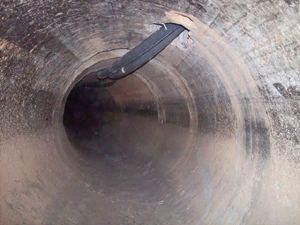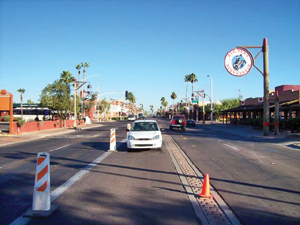Trenchless Used in Traffic Control Project
 Scottsdale, Ariz., is internationally recognized as a tourist destination. The city is known for its spectacular golf course, climate, five-star resorts and recreational amenities, as well as a downtown peppered with urban “boutique” hotels, exciting nightlife, numerous events and attractions, the Sonoran desert, art galleries and world-class restaurants.
Scottsdale, Ariz., is internationally recognized as a tourist destination. The city is known for its spectacular golf course, climate, five-star resorts and recreational amenities, as well as a downtown peppered with urban “boutique” hotels, exciting nightlife, numerous events and attractions, the Sonoran desert, art galleries and world-class restaurants.
Having a population of only 210,000 people, the City of Scottsdale hosts an estimated 8.1 million visitors annually who bring in more than $3.6 billion to the local economy.
With this annual population surge, the local infrastructure and municipal services are challenged. The city spends an estimated $24.5 million annually in operation costs to support its visitors. Due to the city’s proximity to Phoenix and the mountains, the ability to build highways and transportation services to service the influx of people is impossible.
As part of a citizen survey in 1995, Scottsdale residents identified traffic congestion as the No. 1 priority for improvement. Scottsdale began the deployment of CCTV cameras at intersections that carried the most traffic volumes and were the most critical to Scottsdale drivers. Having more than 50 police officers deployed at these intersections, they were replaced by one officer who was stationed at a traffic management center (TMC) and was responsible for automatic and manual control of congested signalized intersections.
Through the success of this program, the city has expanded 50 CCTV cameras in as many intersections throughout Scottsdale, including more than 25 fixed dynamic message signs (DMS), which gives drivers real-time traffic information at key locations throughout town. They can also control specific intersections in the event of collisions and road closures. The TMC can extend green lights in any direction, or implement one of 18 directionally-based timing plans for those events that are longer than a half hour duration. The backbone for this network is distributed through the city’s own fiber network.
Wanting to expand this network further to control traffic in high-volume areas, Scottsdale designed the Indian Bend Wash ITS project with ITS Engineers & Constructors Inc. located in Phoenix. ITS designed this project to utilize the robotic installation of a conduit in more than 16,000 lf of storm sewer along some of the most heavily traveled streets in Scottsdale. This type of design allowed for the following advantages:
- Greater economic efficiency than open-cut construction. A savings of 33 to 66 percent over traditional construction builds.
- No excavation or street cuts needed.
- No excessive noise, traffic or environmental issues. The worksite is out of sight and typically 48 in. or deeper below the ground.
- No requirement for right-of-way or easement permits with municipal access agreement in place.
- High installation speed — typically eight to 10 times faster than traditional construction methods.
- No disruption to residents, businesses or tourists.
Annette Grove is Scottsdale’s senior project manager and she managed the project through the design, award and construction process. The contract was awarded to Mesa, Ariz.-based Rural Electric Inc. Due to the large pipe sizes of 36 to 96 in., a robotic installation was not possible. Rural subcontracted the trenchless installation of the fiber conduit to Columbus, Ohio-based Ca-Botics Fiber Systems LLC.
Ca-Botics dispatched supervisory personal from Ohio to begin the project in September 2008. Project superintendent, Richard Edgell supervised a crew of six workers who were responsible for the pulling and the installation of two 1 ½-in. conduits in each pipe. These conduits were anchored using a 1 ½-in. galvanized metal pipe strap and masonry bolts, spaced every 10 ft.
 With manholes located sometimes more than 1,000 lf apart, Edgell realized that it would be difficult to use wired drills and equipment. Therefore, heavy-duty, battery-operated drills and tools were used along with battery-operated lighting. Fall protection and confined space equipment were operated at each manhole and the working environment was monitored continuously.
With manholes located sometimes more than 1,000 lf apart, Edgell realized that it would be difficult to use wired drills and equipment. Therefore, heavy-duty, battery-operated drills and tools were used along with battery-operated lighting. Fall protection and confined space equipment were operated at each manhole and the working environment was monitored continuously.
All personnel were trained and certified in confined space access. Ca-Botics contracted with local CCTV contractor Pro-Pipe for the pipeline inspection and Rural Electric superintendent Jim Imbrescia, pulled the fiber through these conduits and excavated from designated drops to the traffic control cameras. Due to the heavy traffic along Scottsdale Road, the conduit was pulled during the night when it was less congested. Using the center island, Ca-Botics placed its truck and equipment over manholes and were able to work during the daytime in attaching the conduit to the pipe crown. Working within the allowed time schedule stated in the contract did not hinder Ca-Botics productivity.
Ca-Botics was able to complete the conduit installation in less than 40 days with much of this work is being done in the historic Olde Town. Using traditional construction methods would not only have taken up to 10 times longer but would have disrupted all of the neighboring businesses that rely on the tourist industry which would have been interrupted.
Fiber in the sewers is more attractive today as an option for fiber builds and should be considered as a viable tool to be in every telecom, Internet service provider and municipality’s toolbox. It’s not a cure-all but a tool that can and should be used with existing construction processes to include open-cut and horizontal directional drilling. It is a proven technology with fiber/conduit that has been in the ground for more than 10 years and with no problems.
Jack J. Conie III is president and CEO of Ca-Botics Fiber Systems, based in Galloway, Ohio.
![]()
